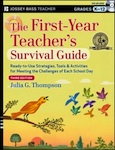How to Be a Culturally Responsive Teacher
Julia Thompson, a practicing teacher for more than 35 years, considers what it means to have a culturally responsive classroom and the steps necessary to create one. Adapted from her book The First-Year Teacher’s Survival Guide.
In the early years of the 21st century, we are constantly and unconsciously bombarded with messages from the various societies that surround us. From restaurant choices, music, sports, fashion, and all forms of popular media to proceedings as significant as wars and threats of terrorism, we adults function in a culturally diverse world. Our students share that world with us, and they need our help in learning to negotiate the complexities of a multicultural society.
One of the most enduring strengths of the public school system in America is the variety of cultures that meet peacefully in thousands of classrooms each day. In classroom after classroom, students of all different races and cultural backgrounds study together.
At a time when school systems are scrutinized and criticized from many sides, classroom diversity is one of our nation’s greatest assets.
Although some people try to define culture in ethnic or racial terms, a broader definition is more accurate. Every person belongs to a variety of cultural groups delineated by such features as geography, age, economics, gender, religion, interests, or education level. If you ignore the cultural differences among your students, you will create strife and tension. Conversely, if you choose to accept and celebrate those differences, you will find them to be a rich resource for your class.
Here are some general guidelines you can use to incorporate the many cultures in your classroom into a successful and unified group:
Check your attitudes and set the tone
- Be aware that your own attitudes are influenced by your own culture. If your students’ cultures are different from yours, you should strive to be sensitive to the differences in attitudes that you may have.
- It is crucial to the success of your students that you make it clear to them that all students in your class are expected to succeed. Cultural differences are to be celebrated and not used as an excuse for lowered expectations. It is only respectful to have high expectations for every student.
- Expose your students to a wide variety of cultures throughout the term. This exposure will enable them to be more tolerant of each other’s differences. Instructional materials should incorporate multicultural information and approaches whenever possible.
- Take it upon yourself to learn as much as you can about the different cultures in your classroom. Read as much as you can. Search the Internet. Talk to other teachers and school personnel about finding appropriate resources to help you with this. Once you are aware of some of the subtle differences among your students, you will find it easy to be a more effective teacher.
Engage your students in culture conversations
- Make it obvious that you appreciate and value your students’ cultures. Provide frequent icebreakers so that you and your students can learn about each other.
- Make discussing the cultures in your class an important part of what you and your students do together. You can manage a few minutes every now and then for an informal discussion without losing valuable instructional time.
- Provide plenty of structured activities where students can interact in a productive way with each other so that they have an opportunity to learn about each others’ cultures. By offering activities that require successful collaboration and that also expose students to a wide variety of world cultures, you will broaden your students’ understanding of the material under study, of each other, and of the world.
- Other activities that allow students to learn about their classmates’ cultures can include marking birthplaces on a large map; creating a word wall of common words, such as thank you or please, in other languages; and having students post photos or images from their culture on a bulletin board or class Web page.
Watch for potential culture conflicts
- Because cultural differences can sometimes lead to misunderstandings, be alert to the potential for student conflict so that you can prevent or minimize it.
- Be very clear about your behavior expectations so that the classroom culture you create can serve to guide student actions and interactions in the classroom.
- Stress to students the importance of an open-minded attitude about people whose beliefs or lifestyles are different from theirs. Make sure you model that acceptance yourself.
- If students learn racism or intolerance at home, know that you will have a very difficult time stopping it in class. Your first step in combating intolerant attitudes should be to make your position of tolerance very clear to your students through what you say and what you do.
Pay attention to families and communities
- Accept that the concerns of a parent or guardian who is not part of your culture may be different from the concerns that you have. If you are sensitive to the potential differences when you speak with family members, you will find yourself asking questions that will help you determine what their goals for their child are before you attempt to impose your own beliefs.
- Explore the resources in your students’ community that can help you reach all of your students. Ask community leaders to make presentations, go on local field trips, or have guest lecturers on various topics of interest to students.
Provide culturally responsive instruction
- Promote activities that will increase your students’ self-esteem. Students who are self-confident are not as likely to taunt others to feel good about themselves. Be positive in your feedback so that students know what the criterion for success is in their classroom.
- Because different cultures stress different ways of learning, you should design instruction that offers a variety of differentiated strategies that students can use to access the material. You should also offer as much appropriate scaffolding as possible.
- Be sensitive to the various ways that different cultures promote learning when designing scaffolding of instruction and make use of those differences. For example, some cultures stress the importance of cooperative learning while others do not. Offer a variety of culturally sensitive ways for students to be successful.
Resources that can help you promote cultural sensitivity
There are many easy-to-use online resources available to help teachers who want to include learning projects which will appeal to students while exposing them to a variety of different cultures. Browse the options in this list of sites to make the best decisions possible about the types of projects that you would like to use to involve your students in authentic learning activities that will not only connect them to other classrooms around the globe, but help them see the value in the diversity of cultures that populate their world.
Skype in the Classroom – Skype in the Classroom is a community of teachers who are working together to create Skype lessons and connect K12 classrooms globally through free Skype video, audio and texting.
Global Read Aloud – Global Read Aloud is a teacher-created project with a focus on reading and making global connections by discussing shared books. Three different levels for various age groups.
ePals – At the easy-to-navigate ePals site, teachers and students can collaborate with other teachers and students from over two hundred countries in authentic learning projects. You can join other classrooms in projects that are already in progress or you can design your own project and ask other classrooms to join in.
GLOBE – The Global Learning and Observation to Benefit the Environment (GLOBE) program is a worldwide hands-on, primary and secondary school-based science and education program involving over 25,000 schools worldwide.
International Education and Resource Network – This extensive site offers opportunities for global collaborative projects through its network of 30, 000 schools located in more than 130 countries. It offers numerous project opportunities that cover a wide range of subjects for K-12 students.
The Center for Innovation in Science and Engineering – At this site you will find many different interactive projects appropriate for science classes K-12.
Global School Net – This site offers information for teachers about various global projects and how to find the ones that would be a good match for their classes.
Teaching Tolerance – A well-known source for educators to find “thought-provoking news, conversation and support for those who care about diversity, equal opportunity and respect for differences in schools.”
These two books are particularly informative:
► Lisa Delpit, Other People’s Children: Cultural Conflict in the Classroom (New Press, 2006)
► Gloria Ladson-Billings, Crossing over to Canaan: The Journey of New Teachers in Diverse Classrooms. (Jossey-Bass, 2001)
► And this article by Dr. Lisa Belfield, “Cultural Diversity: Image All the People”.
Teach your students to value their differences. When you do this, you are creating a truly global classroom. And by expanding students’ appreciation of each other, you are showing them how to appreciate the rest of the world.
For more insights, see Valentina Gonzalez’s post
“How to Create Culturally Responsive Classrooms.”







































Great article! I especially like your suggestions on promoting activities that increase the students’ self-esteem. I think of Maslow’s Hierarchy of Needs and the importance of making every child feel a sense of belonging. If teachers can promote activities that allow students to feel proud of their own cultures and help them feel a willingness to learn more about others’ cultures, they are successfully advocating for all students. Thanks for this very insightful article – you’ve given us more than superficial ways to promote and celebrate all students.
I agree this a great artilce. Learning about students’ cultures can definitely help teachers and staff in building authentic relationships with their students. As the article implied, how can teachers build meaningful relationships with their students, if they cannot relate to their world view? Thank you very much for advocating for our students!
I enjoyed this positive, helpful article as well! I would like to offer our book “Kiss, Bow or Shake Hands” as a resource for understanding adult intercultural communications and cognitive styles. It is primarily oriented towards global business travelers, but perhaps it may be of value to teachers at all levels? I appreciate your work, and will definitely look at the two books you recommended. Many thanks, Terri Morrison
I agree this is a great article. Learning about students’ cultures can definitely help teachers and staff in building authentic relationships with their students.